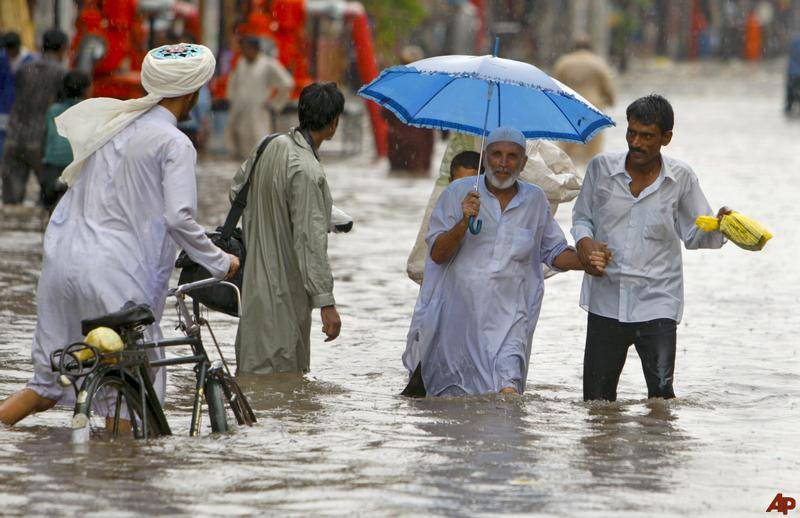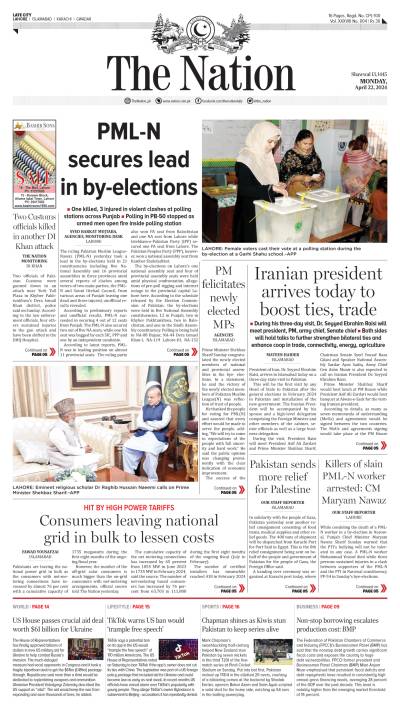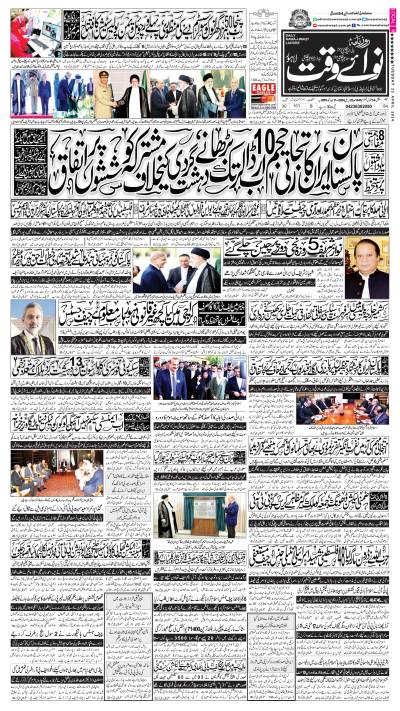A range of hydro-meteorological hazards tend to occur during the summer monsoon period in Pakistan. These include riverine and flash floods, cloud burst, glacial lake outburst triggered by heat and or precipitation, cyclonic activity, onset of drought and heat waves. These events are accompanied by health epidemics like the dengue virus and affect the most marginalized and poor sections of the society. All have varying range of occurrence and consequences of harm which stand accentuated by the climate change phenomenon. Do we have the institutional arrangements, beyond the preparedness and response paradigm to deal with these hazards and their underlying vulnerability triggers?
As per the international disasters database CRED – EM DAT, during the 1990 – 2014 period, floods constituted almost half (46.8%) of the all the natural disasters that occurred in Pakistan; they caused 11.5% of the recorded mortality and 73% of the economic losses. Annual estimated losses caused by floods is a staggering $ 1,029 million during this period. Floods articulate themselves through the Indus and Chenab rivers and along hundreds of flash flood channels. Flooding along rivers Ravi and Sutlej occurs less frequently but still poses a serious hazard to the population and infrastructure intruding into the flood plains. Even modest level of urban flooding poses a peril to human life due to infrastructure failure and deficient storm water drainage. The South Asia Climate Outlook Forum (SASCOF 8) for 2016 predicts an above average monsoons in the western (covering most of Pakistan) and central regions.
Climate change adaptation aimed at limiting the debilitating impacts of floods and other hazards, poses a major challenge. Erratic hazard prone rain patterns tend to be the norm. Very heavy spring rains during March to early April this year has already caused 141 deaths and destroyed or damaged more than 1000 houses as per the National Disaster Management Authority (NDMA), most in KP and FATA. In stark contrast, we have suffered a severe heat wave through May and early June with temperatures frequently exceeding 50 C in the south and remaining well above the comfort level in other regions thus posing threat to life. Such trends coupled with the 2016 monsoon forecasts make for grim monsoon and flood scenarios. So how prepared are we?
Over the years we have managed to address many immediate causes of harm due to the flood hazard. Federal Flood Commission attends to the preparedness of the flood protective infrastructure. NDMA, PDMAs, Army’s Corps of Engineers, Armed Forces, Pakistan Meteorological Department, SUPARCO, Rescue 1122 and host of other actors prepare for, and coordinate diverse responses. The disaster management system has shown adeptness in forewarning and evacuation of the vulnerable population along the rivers’ flood plains. NGOs reinforce efforts in support of the vulnerable communities and the media plays an important role in raising awareness of the hazards.
The planning process incorporates identification of contingent funds to meet emergency relief related expenses. Electronic cash transfers attend to some of the relief cum recovery needs. Similarly the flood early warning system is fairly prompt in acquiring and disseminating information. Its blind spots largely relate to the venues of flash flooding in the northern, north-eastern and western regions.
What will greatly improve the recovery and reconstruction arrangements, is the introduction of a hazard risk insurance and usage of associated financial tools. The social security nets and the micro finance component should contribute more concertedly in rebuilding the livelihoods and social infrastructure. Similarly crops insurance should be introduced. Interventions aimed at reducing vulnerability risks through deployment of financial instruments are widely practiced and supported by the World Bank, ADB and the donors. These can be adapted to our environment.
A word on the underlying vulnerability enhancing factors. Rampant socioeconomic poverty undermines resilience to disasters or unforeseen events. An extremely vulnerable population lives along the flood plains, survives upon subsistence agriculture or daily wages, with weak or non-existent social safety nets, and an extremely poor public health infrastructure. Many suffer from alarming mal-nutrition. The social infrastructure does not comply with any standards and deaths occur owing to the collapse of katcha or poorly built houses. Evidence suggests that natural disasters accentuate poverty and vulnerability patterns in the disaster affected regions.
Poor land use management as evidenced by extensive encroachments in the flood plains is indicative of weak governance. With population densities ranging from 300 to 500 persons per square kilometre along the major rivers, millions reside within the flood protective infrastructure. Coupled with the rampant environmental degradation, these aspects heighten the risks. Environmental losses are evident from deforested watersheds and the depleting mangroves that buffer sea water intrusion. These dynamic pressures largely account for the recurring monsoon losses that cause much suffering besides negating the developmental gains.
Socioeconomic development and climate change adaptation measures are addressed largely through the development agenda. Some priority issues include augmenting our dismal water storage capacity, the climate change driven losses in agriculture productivity and its impact on food security, promoting diverse livelihoods and potable water access in the excessively contaminated riverine regions, pre-empting onset of epidemics and reversing desertification. There is a need to structure the rural development interventions to increase resilience of the vulnerable communities to external shocks.
These issues span multiple themes and sectors and, therefore, there is a need to formulate a cohesive hydro-meteorological hazards management strategy that is enacted over the medium and the long term. Diverse developmental agendas must be harmonised and integrated by the Federal and Provincial governments under the ownership of the Planning Commission and the Planning and Development Departments, respectively. The outcomes must integrate the disaster risk reduction, climate change adaptation and the development agendas. The disaster preparedness, response and the recovery focus should be aligned to the above referred overarching strategy, as applicable in the local environment. The Strategy should be operationalised through multi-tiered and stakeholders’ inclusive forums. It should be supported by resource mobilisation, deploying relevant planning for a, through information sharing and coordination platforms. The private sector’s partnerships should be promoted by deploying appropriate strategies.
Such an overarching monsoon strategy will reinforce vertical and horizontal alignment of diverse efforts under a seamless resilience promoting theme that cumulatively responds to the challenges posed by the range of monsoon hazards and the climate change. Yes we have to deploy matching vision, competence and above all political will to make it happen.






